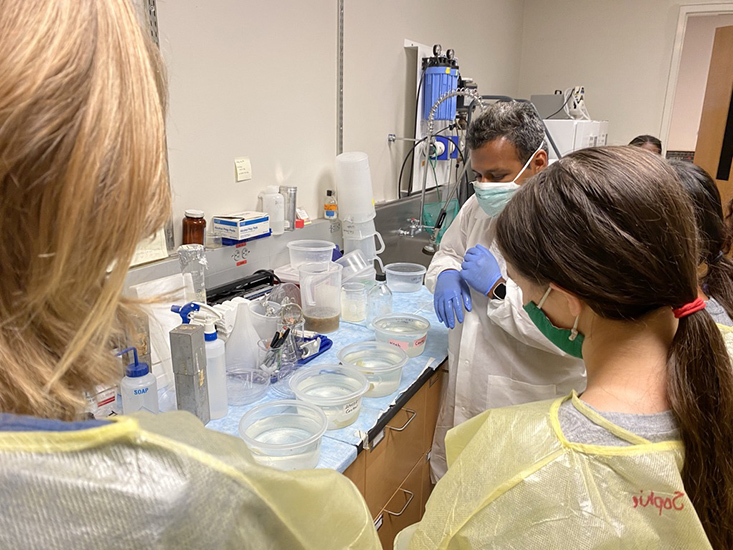Lab rotation: Sea Squirts
Lab leaders: Dr. Larry Dishaw’s Lab (Ojas Natarajan, Celine Atkinson, April Ellis,
& Morgan Young)
Peer counselors: Bella Shuler & Juanita Ruan
Written by, Ojas Natarajan, Lab Leader
In the Dishaw lab, the OCG campers learned that sometimes marine organisms can be used to study how microbes interact with animals, how the gut immune system works, and how microbial communities live in (the gut) and among us and contribute directly to our health. In our lab, we study the marine invertebrate Ciona robusta, commonly known as a sea squirt, and its gut bacteria (that our lab previously isolated and cultured). With this model, we ask questions such as: 1) can animals control which microbes colonize their gut? How are the animals and their microbes impacted by stress, pollution, and climate change?
During the visit, the girls got a flavor of various approaches that are used by the lab to study host-microbe interactions. Ph.D. student, April Ellis, demonstrated how microplastics that pollute our waterways can be swallowed and visualized in the gut. This was done using a method called fluorescent microscopy.
Celine Atkinson, Ph.D. student, introduced the girls to the world of bacteriophages, viruses that infect bacteria. Celine discussed the significance of bacteriophages, and how they impact bacteria in the gut. Together with Celine, the girls performed plaque assays. In this assay, viruses kill the bacteria and leave clear zones that can be counted. This also allows the estimation of viral abundance. The girls were able to experience phage experimentation in vitro (in the lab).
Together with postdoc, Dr. Ojas Natarajan, the girls learned about and performed Gram staining, which is a differential staining technique to observe different kinds of bacteria. The campers were able to visualize the stained bacteria at the microscope at 1000x magnification, noting various types of gut bacteria. Also visualized were bacterial swimming behaviors, which is done by performing a motility assay.
An important aspect of studying the microbes that colonize animals is to use computers and software to analyze various aspects of their genetics and biology using an approach known as bioinformatics. Morgan Young, our bioinformatics scientist, demonstrated how to search for genes and other bits of DNA and protein sequences by looking more closely at the letters that make up their nucleic acids (for DNA) and amino acid sequences (for proteins) using web-accessible database such as NCBI. She also helped the girls better understand how DNA and proteins are studied, and how bioinformatics can help us predict function and help us understand the relationships among microbes. She also provided the campers with important insight on how to scan the internet for published research articles using services such as Google Scholar.
Importantly, the campers got hands-on time with the sea squirts. They made an “unboxing video” of animals arriving from their collection site, and were able to learn about how the animals are raised in the lab, while observing juveniles at the microscope.
Finally, the girls had fun in the lab! They wore personal protective gear and learned to handle pipettors, micropipettes and microfuge tubes. Overall, the campers were exposed to using a ‘simple’ model organism to ask and investigate important scientific questions important to both marine and biomedical research.
View the slideshow below.
